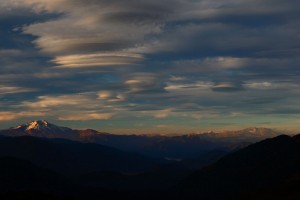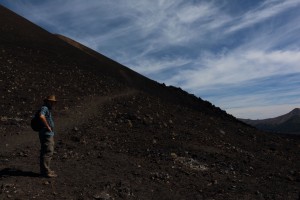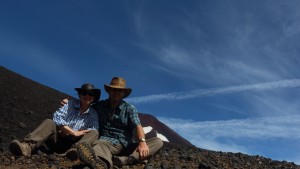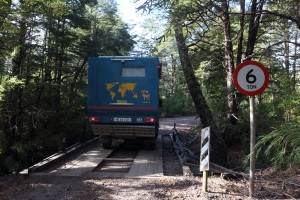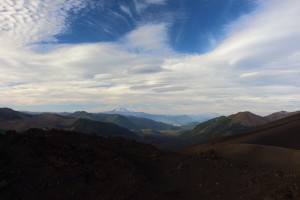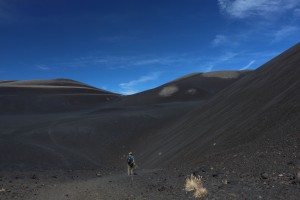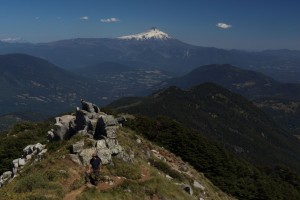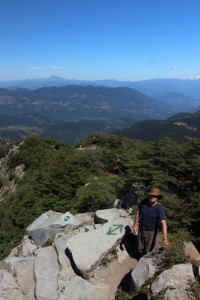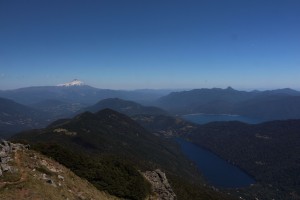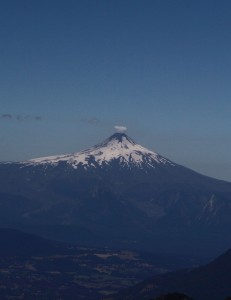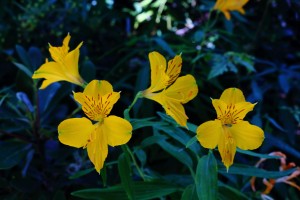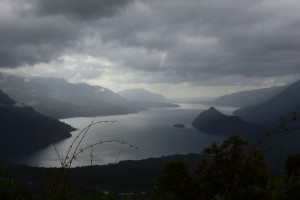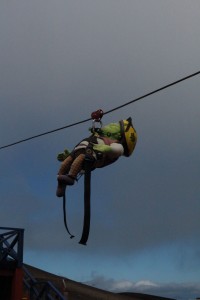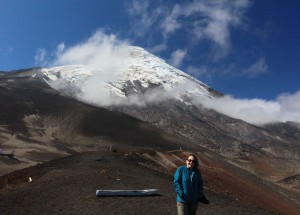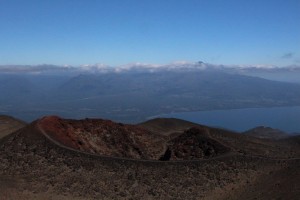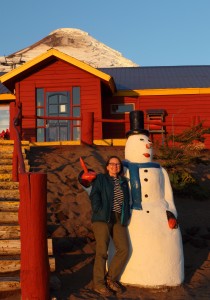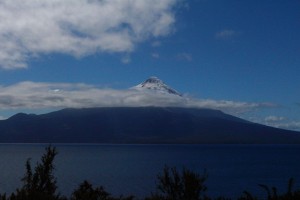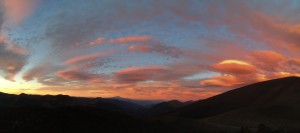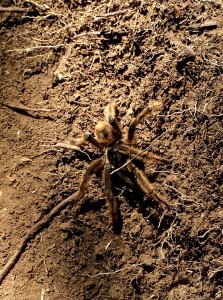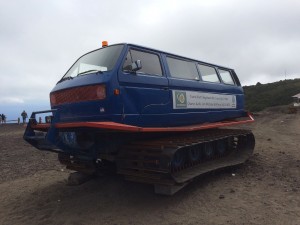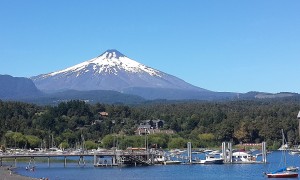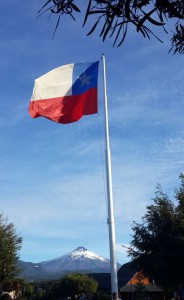Chile is rather famous for its volcanos and has quite a few of them, particularly gathered around the Lake District to the north of Puerto Montt. Now in our view, lakes are lakes. There are many around the world and although often very beautiful, they rarely fascinate in the way that a volcano can. So we found ourselves driving through the Lake District largely ignoring what would otherwise be notably scenic lakes and focussing on the volcanos – several of them very much still active. The most recent eruption was Volcan Calbuco which popped-off less than a year ago on 22nd April 2015, so these aren’t merely relics for geological historians. Here’s out Chile volcanos travel blog…
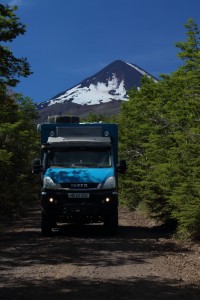 ‘Mystery wobble’ update
‘Mystery wobble’ update
But before we get into volcano detail, the diligent Cuthbert follower will no doubt be impatient to receive an update on the intermittent ‘mystery wobble’ in the rear differential that Cuthbert was carrying at the end of our last blog. Well… the good news is that so far, the problem has not (re)reared its ugly head. Our strong suspicion now, is that the problem was caused when Cuthbert was serviced by the Puerto Montt Iveco mechanic; he probably didn’t tighten the pinion flange nut (how’s that for technical lingo! 🙂 ) properly after changing the seal. Since Marcus investigated the wobble by disassembling and reassembling the rear differential with the correct torque, the problem seems to have disappeared.
Anyway… by the time all this had been sorted, we had lost the appetite for returning again on the ferry to finish our tour of Chiloe island. Instead you find us now heading north a bit to the Chilean lakes and volcanos (but not so far north that we can’t do a quick detour back to Puerto Montt again when our previously ordered spare parts have arrived from Iveco Italy).
Volcano-tastic
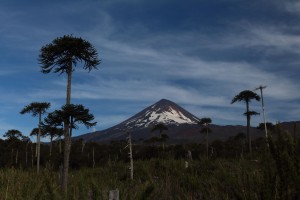 Now… where were we with the volcanos? Ah yes… the chain starts with Volcan Calbuco overlooking Puerto Montt, but we headed first to Volcan Osorno which has a small ski resort in winter. We drove up to the base-lifts before setting out on a short afternoon hike to take in the views, then parked-up on the hillside for the night and a stunning sunset. Sunrise is also likely to have been rather fine, but unfortunately we’re not in a position to either confirm or deny that rumour 🙂
Now… where were we with the volcanos? Ah yes… the chain starts with Volcan Calbuco overlooking Puerto Montt, but we headed first to Volcan Osorno which has a small ski resort in winter. We drove up to the base-lifts before setting out on a short afternoon hike to take in the views, then parked-up on the hillside for the night and a stunning sunset. Sunrise is also likely to have been rather fine, but unfortunately we’re not in a position to either confirm or deny that rumour 🙂
Over the next few days we continued north past Volcans Puntiagudo and Puyehue but soon our luck with the weather ran out. We drove up to the base point to start our hike on Volcan Coshuenco but as we drove up through the cloud we could see that there was little point in getting out of Cuthbert. Oh well! Onwards we go… there are many more to come on the Great Volcano Tour and as we continued north the weather soon improved to hot sunny days with almost cloudless skies.
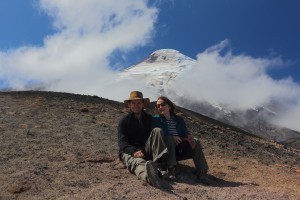
Volcan Osorno
Next stop was the Volcan Villarrica and its nearby towns of Villarrica and Pucon. We rather naively contemplated signing-up to climb to the crater rim of the great Volcan Villarrica, that is until we learned that this is a proper climb, not some hike-in-the-park for the moderate enthusiast such as us. The top section is technical and extremely strenuous with dangerous conditions and ice-walls to be tackled with crampons and ice-axes.
Hmmmm… me thinks that our little day-hike on the Perito Moreno glacier a few weeks ago probably won’t provide the requisite level of previous experience to tackle this one. We’ll just have to bravely sit back in the sunshine and take in the stunning view of Volcan Villarrica from the comfort of a restaurant terrace by the lake, watching it occasionally puffing up huge vents of smoke. And while we’re here… we may as well take in one of those delicious filet steaks washed down with a splash of Chilean red. Don’t mind if we do, thanks! 🙂
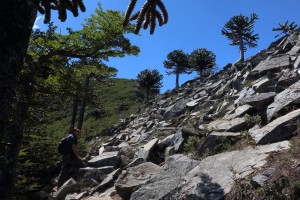 So if we couldn’t ‘do’ Volcan Villarrica, we could at least take a hike to the crater rim of a long extinct volcano in the nearby Huerquehue National Park. A tough but rewarding day hike with a 1,500m height-gain took us to a point from which we could survey the whole of the surrounding area, taking in a view of not one, not two, but eight snow-capped volcanos in the panorama. It was very spectakliah 🙂 , including the tarantula that we spotted on the way up!
So if we couldn’t ‘do’ Volcan Villarrica, we could at least take a hike to the crater rim of a long extinct volcano in the nearby Huerquehue National Park. A tough but rewarding day hike with a 1,500m height-gain took us to a point from which we could survey the whole of the surrounding area, taking in a view of not one, not two, but eight snow-capped volcanos in the panorama. It was very spectakliah 🙂 , including the tarantula that we spotted on the way up!
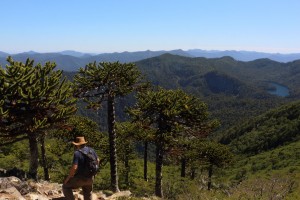 One of the eight volcanos in the view was the previously mentioned Volcan Villarrica (the one which we had ‘chickened-out’ of climbing a couple of days before) but our substitute steak-and-wine experience by the lakeside was shown to be an even more shrewd move when we learned that Volcan Villarrica is extremely active. If there is one crater to climb to at the moment, this is probably not it. Other very active volcanos in the region include Volcan Llaima, the most active over recent years having erupted in 1984, 1994 and 2003. By my reckoning, that sequence makes it now a couple of years over-due!
One of the eight volcanos in the view was the previously mentioned Volcan Villarrica (the one which we had ‘chickened-out’ of climbing a couple of days before) but our substitute steak-and-wine experience by the lakeside was shown to be an even more shrewd move when we learned that Volcan Villarrica is extremely active. If there is one crater to climb to at the moment, this is probably not it. Other very active volcanos in the region include Volcan Llaima, the most active over recent years having erupted in 1984, 1994 and 2003. By my reckoning, that sequence makes it now a couple of years over-due!
Run this way
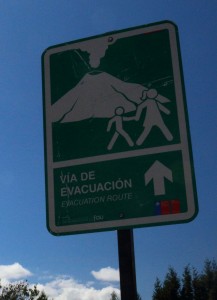
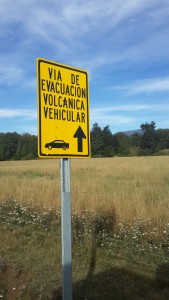
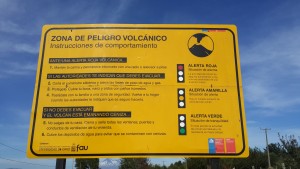 Cuthbert followers from ‘safer’ parts of the world may at this point be wondering why anyone would want to live in the shadow of so many active volcanos and what these residents do in the event of a looming eruption. Well they are probably comforted by a network of ‘traffic light’ warning signs placed strategically around the potentially affected areas.
Cuthbert followers from ‘safer’ parts of the world may at this point be wondering why anyone would want to live in the shadow of so many active volcanos and what these residents do in the event of a looming eruption. Well they are probably comforted by a network of ‘traffic light’ warning signs placed strategically around the potentially affected areas.
A ‘Red’ indicates a ‘State of Alarm’: volcanic activity is accumulating and a major eruption is likely. ‘Amber’ indicates a ‘State of Alert’: a notable amount of volcanic activity. ‘Green’ indicates a ‘State of Calm’: volcanic activity is normal (note: not that there is no volcanic activity; there is activity, it’s just normal 🙂 ). There are signs with instructions on what actions to take if an Amber or Red alert is indicated and there are various direction signs along the local roads showing evacuation routes for people escaping on foot, and for those in vehicles.
Christmas Crater
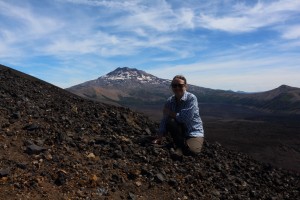
On the rim of Christmas Crater
Several of the main volcanos which form the impressive sky-line along the Chilean Lake District are themselves not hugely active through their main cone. They have however, produced large eruptions through ‘side-holes’ of the main cone (better known by smarty-pants people as ‘parasitic pyroclastic cones’). Crater Navidad, meaning Christmas Crater (no prizes for guessing when…), is a relatively accessible example of the parasitic pyroclastic cone, sitting on the side of Volcan Lonquimay in the Malalcahuello National Reserve. It last erupted in 1988 creating a lava-flow over 10 km long, so we hiked down a path, a couple of kilometres through the moon-like barren and black lava fields to investigate Crater Navidad.
Climbing up the side of the volcano in the fresh (well… less than 30 years is relatively fresh in geological terms) lava flow was much harder work than it looked. A bit like climbing a steep sand-dune, each step forward into the loose volcanic ash and lava-shingle slides back down lower than when you started the step. It’s a knee-killer, but worth it for the great view into the deep crater.
On the way up – just in case we needed a reminder of how bubbly the sub-strata of the region really is – we looked out at the magnificent views to see Volcan Copahue (about 50 km away just over the border to Argentina) in the middle of one of its regular minor eruptions. There is something mildly disconcerting about standing on one volcano whilst watching another one erupt, but the ‘traffic light’ warning was ‘green’, so we crossed our fingers and hoped that the seismic gurus were ‘on the ball’ with this one.
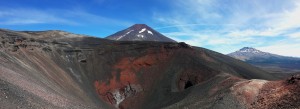
Of course… it’s a parasitic pyroclastic cone
Heading down from the parasitic pyroclastic cone crater is now another story! If we thought the climb up there was a challenge, coming back down was yet more ‘fun’. For those unfamiliar with the sport of snow skiing, there is a technique known as ‘side slipping’ – sliding side-ways on your skis to tackle a very steep descent. Well… we did this down the side of a volcano… only minus the skis. We just stood sideways on the lava-shingle slope and our feet slid downwards at a slightly alarming rate – but we made it. Adventure over and back to Cuthbert for tea and biccies 🙂
Hunter-gatherers
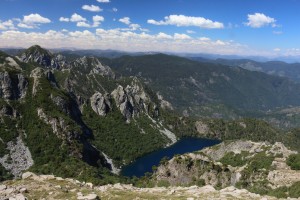 Still biding our time before returning to Puerto Montt for Iveco stuff, in addition to the volcano stuff we have been doing a bit more of the ‘Good Life’ living off the land. Well… slight exaggeration… we’re not exactly Bear Grylls and we are rather partial to supermarket chocolate biscuits, but regular Cuthbert followers may recall that we were rather proud to catch our first fish a few weeks ago in Argentina.
Still biding our time before returning to Puerto Montt for Iveco stuff, in addition to the volcano stuff we have been doing a bit more of the ‘Good Life’ living off the land. Well… slight exaggeration… we’re not exactly Bear Grylls and we are rather partial to supermarket chocolate biscuits, but regular Cuthbert followers may recall that we were rather proud to catch our first fish a few weeks ago in Argentina.
Well, it is now late-summer here in the southern hemisphere and we’ve been out collecting wild fruit. I must confess that until I gave up work two years ago for this travelling-malarkey, a Blackberry to me was the item attached firmly in my right-hand for me to dispense legal advice, at ridiculous times of the day/night, to demanding clients. Now a blackberry is something I go out with bowl to collect in the countryside and make into yummy desserts. It’s unlikely that we’ll progress to snaring and spit-roasting a wild boar over an open fire, but it is rather satisfying to be a bit more ‘green’ and have zero food-miles on our plate 🙂
Iveco Games (again)
Finally we have received notice from Iveco in Puerto Montt that Cuthbert’s spare parts have arrived from Italy and are ready for collection. Yeeeyyhhh!
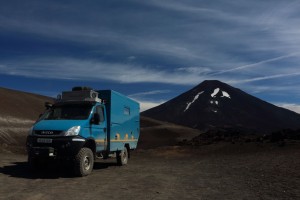 Recently we have received emails from owners of Iveco Daily 4x4s in other parts of the world asking about our overall experience with Iveco in South America. So, at the risk of boring everyone else (and kindly excuse the lack of technically accurate terminology) we’ll recap the Iveco story briefly…
Recently we have received emails from owners of Iveco Daily 4x4s in other parts of the world asking about our overall experience with Iveco in South America. So, at the risk of boring everyone else (and kindly excuse the lack of technically accurate terminology) we’ll recap the Iveco story briefly…
We brought Cuthbert to Iveco in Chile for his 80,000km service because, as far as we know, it’s the only country in South America where Iveco has introduced the Daily 4×4 to the market. This gave us a small amount of confidence that all would be ‘cushty’. The chaps were indeed very friendly and helpful, but the frustration started when all the spares we wanted had to be ordered from Italy. The prices were just over double the equivalent in UK, but we needed them so we placed the order. In the meantime, they did Cuthbert’s 80,000km service, but Marcus’ discussions with the mechanic indicated first, a distinct lack of familiarity with the 4×4 model and secondly, an absence of some of the specialist Iveco tools.
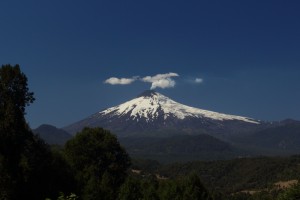
Just another minor eruption!
After the service and whilst waiting for the spares from Italy, we set off on a loop-trip through nearby Chiloe island, but we had to cut this short and return to Iveco for them to check-out a ‘mystery wobble’ in the rear differential. The Iveco mechanic couldn’t work out what it was, so Marcus took the rear-diff apart himself and tightened everything up. After this, no further problems …so far!!!!
Anyway… with the possibility that the bearing might need replacing at some stage in the near future, we spent days scouring the motor-spares and tool shops of Puerto Montt for the necessary bits so that Marcus could do the job on the road if necessary. Finally, the spares that we ordered from Italy arrived after 4 weeks, so Marcus can do all the techie-stuff he wants and we can say our farewells to the nice Miguel at Iveco, Puerto Montt (note: techie-type readers can click on the link to see the detail in ‘glorious technicolour’ with Marcus’ technical write-up).
White turns Black
Just before finally leaving Puerto Montt, we read in the Chilean national press that there is concern about global warming and the ‘El Niño’ factor on Volcan Osorno. When we went up there just three weeks ago there was a generous coating of snow on the top of the cone. As we drive back past the same volcano to exit Chile today, we can indeed confirm the media reports that a large part of the previously white area is now black.
By all accounts, this is the first summer on record that the snow has melted on the high levels of Volcan Osorno and the environmental chaps are having a field-day. It has excited the ice-climbers as they take their lives in their hands, climbing to witness at close quarters the vast slabs of compacted snow sheering off the rock-face. Now… we are no environmental gurus, and there is almost certainly a range of scientific views as to how and why this might be happening, but we can say that there is no mistaking the evidence – the white is now definitely black!
Anyway… of far greater significance than any global warming or ‘El Niño’ effects on the planet… we are at last ready to move on properly, without a return to Puerto Montt looming on the horizon! Hurrah!!! We have been fortunate in that there is much to see and do within a few hours drive both north and south of Puerto Montt, so we haven’t been at all bored during the ‘Iveco Games’ delays. However, we have now seen just about everything there is to see in this part of Chile and we are itching to move on… next we’re off for a bit of border hopping… back to Argentina again! Toodle-pip for now 🙂
Link to next blog: From Dinosaurs to Space Town Link to full South America Blog
Volcano-land Gallery
- Just another eruption!
- Volcan Villarrica

